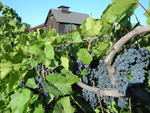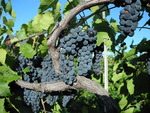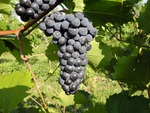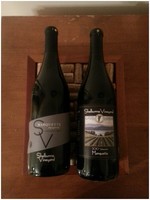 Shelburne Vineyard's Winery and Tasting Room on Route 7Have you ever tasted a wine that you liked so much that you had to go out and buy a bottle? How about a case? How about two cases? How about an entire winery?
Shelburne Vineyard's Winery and Tasting Room on Route 7Have you ever tasted a wine that you liked so much that you had to go out and buy a bottle? How about a case? How about two cases? How about an entire winery?
For Ken Albert, founder of Shelburne Vineyard, that was precisely what happened when he first tasted an experimental batch of Marquette at a conference hosted by Cornell in the early 2000's.
"The first taste of it blew me away, and I couldn’t believe this was a hybrid grape," Ken said. "Based on that tasting, and a little bit of research and talking to people, we decided to invest in our winery. So basically, Marquette is the reason we built our building."
Completed and opened for operation in February 2008, Shelburne Vineyard's winery and tasting room (on Route 7 in Shelburne, Vermont) is a prime example of the rapid rise that Vermont viticulture has experienced over the past 5 years. In the summer of 2007, I tasted Shelburne Vineyard's Cayuga White at the Killington Wine Festival. The wine was fresh, crisp, and lively, with citrus flavors and a piercing acidity that was reminscent of an Alsatian Pinot Blanc. "I can't believe this wine is from Vermont," I said to myself.
Back then, the concept of my home state having any kind of quality viticulture and winemaking was a novel concept to me, and I was not alone in my opinion. In June of 2008, I joined BRIX Wine Shop in Boston, as a wine consultant. From time to time, over the course of the next year, my customers who were interested in local wines would ask me if there were any quality wines in Vermont. Emboldened by my experience at Killington, I enthusiastically sang the praises of Vermont's white wines, although my endorsement was often met with a skeptical glance by my questioning customers. No one, it seemed could believe that Vermont, a state known for its skiing, maple syrup, and Ben & Jerry's ice cream, was capable of making quality wines. Occasionally, I could gain a measure of acceptance for my claims by pointing out that Germany has a climate with cold temperatures similar to Vermont, but in general, my praises for Vermont wines fell on deaf ears.
 Marquette grapes on the vine at Shelburne VineyardPrior to 2008, Shelburne Vineyard's wines were produced in what Ken described as a small small scale operation in a leased winery building. While Ken had over 35 years of personal experience growing grapes, it was not until 1998, following his retirement from IBM, that he planted his first commercial vineyard, on land leased from Shelburne Farms. He planted a second vineyard in 1999, and 2000 would represent Shelburne Vineyards' first vintage, which was released in 2001. It was not until 2006 that the winery expanded to a 14-acre plot on Route 7 in Shelburne, and began construction of its tasting room and winery. Marquette was introduced by the University of Minnesota that year, and along with the white grape, Louise Swenson, was the only grape planted in the inaugural plantings of the Shelburne Road Vineyard.
Marquette grapes on the vine at Shelburne VineyardPrior to 2008, Shelburne Vineyard's wines were produced in what Ken described as a small small scale operation in a leased winery building. While Ken had over 35 years of personal experience growing grapes, it was not until 1998, following his retirement from IBM, that he planted his first commercial vineyard, on land leased from Shelburne Farms. He planted a second vineyard in 1999, and 2000 would represent Shelburne Vineyards' first vintage, which was released in 2001. It was not until 2006 that the winery expanded to a 14-acre plot on Route 7 in Shelburne, and began construction of its tasting room and winery. Marquette was introduced by the University of Minnesota that year, and along with the white grape, Louise Swenson, was the only grape planted in the inaugural plantings of the Shelburne Road Vineyard.
It seems shocking that a red grape would be responsible for the success of a Vermont winery. The general assumption is that cold climates can produce quality white wines that are either slightly sweet, brightly acidic, or sometimes both. The famous Rieslings of cool climates such as Germany and New York's Finger Lakes help propagate this myth. Yet, while most people associate great red wines with Mediterranean climates such as Tuscany, California, or France, cool climates are most certainly capable of producing great red wines. Germany is the third-largest Pinot Noir in the world, and red wines from the Finger Lakes have gained significant publicity over the past two years. Unfortunately, Vermont's climate, especially the winters, are colder than those two regions. When I spoke to Ken, he noted that before he planted Marquette, the cold winters posed a major threat to the viability of his crops of red grapes.
"I was growing French-American hybrids, and they were, based on my experience, marginally hardy in Vermont," Ken said. "Depending on the previous winter, you could get a full crop, or only a partial crop. If the temperature dropped below -15ºF for enough hours, it would kill the buds, and of course the buds that form in the fall, are the grapes that form the next year."
Vermont's winters are generally so cold that very few commonly known European (Vitis vinifera) grapes can thrive here, if they can grow at all. French-American hybrids are a cross between Vitis vinifera and Vitis labrusca, but have a greater percentage of Vitis labrusca in their genetics. Vitis labrusca is native to the Eastern United States, and is the species of grape to which varietals such as Concord and Catawba belong. In addition to their marginal hardiness, French-American hybrids can be problematic for winemakers, because the foxy, or grapey character of the Vitis labrusca grapes sometimes shows through. "There’s always the challenge of getting that foxiness out of the hybrids," Ken said.
The University of Minnesota's breeding program has been working to develop cold climate hybrid grapes by breeding Vitis vinifera species with Vitis riparia, a species of grape native to the Midwestern United States that is commonly known as the River Bank Grape. The program has had some definite successes, such as the red grape Frontenac, and the white grape La Crescent. Both of those grapes have been successfully grown in cold climate regions, including Vermont, but despite the fact that it was introduced only 6 years ago, it is Marquette that has generated the greatest degree of critical acclaim.
Critics have lamented the fact that while Frontenac had proved to be exceptionally hardy in cold climates, it has not consistently been capable of producing world-class wines. Prior to the first time I tasted Marquette, I would have said the same thing about most Vermont red wines. Five years ago, Vermont's red wines could be likened to a grab-bag, with varying degrees of quality existing across the sample. You could find well made wines, but when you tasted them, it was seemingly necessary to evaluate them as a separate category. There was an obvious difference between a "Vermont wine," and a wine from California, Oregon, Washington, or New York.
Commercial vineyards are generally not harvested until 2-3 years after they are planted, and consequently, Shelburne Vineyard did not harvest its first vintage of Marquette until the fall of 2008, after planting the vines in the spring of 2006. I moved back to Vermont from Boston in the summer of 2009, and that fall, I had my first opportunity to taste a Vermont wine made from Marquette. My reaction to that first taste was probably similar to the one that Ken had at the conference hosted by Cornell. The wine was rich and full bodied, with dark fruit flavors that intermixed with hints of bacon and cured meats. Tasted blind, I could have easily confused the wine for a Northern Rhone Syrah, as it also possessed good acidity, and the purity that is characteristic of that heralded region.
 A close-up of MarquetteThe grape's origins trace to a cross-breeding of another University of Minnesota grape, MN 1094, and the French hybrid cultivar, Ravat 262. Marquette's lineage is complex, but it is recognized as a cousin of Frontenac, and as a grandson of Pinot Noir. It is able to withstand temperatures up to -35ºF, and is highly resistant to downy mildew, powdery mildew, and black rot. When I spoke to Ken, he was quick to expound on other merits of the grape, such as the fact that it ripens with a tremendous amount of acidity and a tremendous amount of sugar. Ken mentioned that the high sugar levels were the product of its Vitis riparia parentage, and contributed to the wine's rich character. He also added that while the high levels of acidity in the grape were a challenge at first, over time, they had learned to manage the high acidity levels through malolactic fermentation.
A close-up of MarquetteThe grape's origins trace to a cross-breeding of another University of Minnesota grape, MN 1094, and the French hybrid cultivar, Ravat 262. Marquette's lineage is complex, but it is recognized as a cousin of Frontenac, and as a grandson of Pinot Noir. It is able to withstand temperatures up to -35ºF, and is highly resistant to downy mildew, powdery mildew, and black rot. When I spoke to Ken, he was quick to expound on other merits of the grape, such as the fact that it ripens with a tremendous amount of acidity and a tremendous amount of sugar. Ken mentioned that the high sugar levels were the product of its Vitis riparia parentage, and contributed to the wine's rich character. He also added that while the high levels of acidity in the grape were a challenge at first, over time, they had learned to manage the high acidity levels through malolactic fermentation.
"We’ve learned more and more every year about how to best vinify it," Ken said. "You don’t have to use artificial methods to reduce the acid. You just have to allow it to go through malolactic fermentation, which every red wine goes through. If you're just patient that way, and go with what the grape wants to do, you can make some really great wine with it, without going through any artificial interventions. We’ve moved to minimal intervention, because it makes good wine almost by itself."
As I talked to my wine loving friends about their experiences with this grape, I found that I was not alone in my thinking that this could be the grape that put Vermont viticulture on the map. After several conversations, friends and I affectionately dubbed Marquette, "Vermont's Malbec," referring to the fact that although Malbec is native to Cahors, France, it was only when it was brought to Argentina, that it produced wines that bestowed international fame on both the grape and the region. Similarly, although Marquette was developed at the University of Minnesota, it has truly thrived in Vermont, as multiple Vermont wineries have won medals for their Marquette wines. In 2009, Lincoln Peak Vineyard, another Marquette pioneer, won Best-in-Show Red at the International Cold Climate Wine Competition (ICCWC). This past year, it was Shelburne Vineyard's turn, as their 2010 Marquette Reserve won Best-in-Show Red at the 2012 ICCWC.
 2010 Shelburne Vineyard Marquette and 2010 Shelburne Vineyard Marquette Reserve The 2010 was the first vintage of the Marquette Reserve for Shelburne Vineyard, and is only available at the winery's tasting room. On a trip to Shelburne vineyards earlier this fall, I bought a bottle, and as I was writing this column, I opened it up alongside a bottle of the 2010 Shelburne Vineyard Marquette that I had purchased the previous year. The 2010 Marquette won the Best-in-Show Red at the 2011 ICCWC, and tasting the two alongside each other was a real treat. The 2010 Marquette showed brighter acidity, and was more reminiscent of a Northern Rhone Syrah with pure dark fruit flavors, and a hint of cured meats. Meanwhile, the extra oak aging given to the 2010 Reserve added weight and body to the wine, giving it a rounder mouthfeel, and accentuating the jamminess of its dark fruit flavors. Tasted blind, one could easily confuse it for a top-tier Côtes du Rhône Villages or an entry-level Châteauneuf-du-Pape.
2010 Shelburne Vineyard Marquette and 2010 Shelburne Vineyard Marquette Reserve The 2010 was the first vintage of the Marquette Reserve for Shelburne Vineyard, and is only available at the winery's tasting room. On a trip to Shelburne vineyards earlier this fall, I bought a bottle, and as I was writing this column, I opened it up alongside a bottle of the 2010 Shelburne Vineyard Marquette that I had purchased the previous year. The 2010 Marquette won the Best-in-Show Red at the 2011 ICCWC, and tasting the two alongside each other was a real treat. The 2010 Marquette showed brighter acidity, and was more reminiscent of a Northern Rhone Syrah with pure dark fruit flavors, and a hint of cured meats. Meanwhile, the extra oak aging given to the 2010 Reserve added weight and body to the wine, giving it a rounder mouthfeel, and accentuating the jamminess of its dark fruit flavors. Tasted blind, one could easily confuse it for a top-tier Côtes du Rhône Villages or an entry-level Châteauneuf-du-Pape.
The fact that Vermont's Marquette-based wines are frequently confused with for wines is perhaps the best indication of the grape's world class. At the 2012 ICCWC, judges were convinced that Shelburne Vineyards 2010 Reserve Marquette contained grapes from California. There were none, but the judges' confusion is a prime example of the distinctive depth and concentration that Marquette-based wines can achieve in Vermont.
"I don't want to sound snotty, but I think Marquette is the first Vermont red wine I've had that actually tastes like a true red wine," said one of my friends in the wine industry. "It have a complexity and depth of flavor that just isn't found in other Vermont reds. It can stand on its own against wines from California, Italy, France and the rest of the world. It doesn't need to be evaluated as a 'Vermont wine.' That being said, if I had to pick one wine to show visitors what Vermont wine is capable of, it would be Marquette."
Vermont has traveled a tough road in terms of convincing the general public that its wines deserve to be taken seriously, and Shelburne Vineyard has been at the forefront of that journey. Marquette-based wines may currently lack their own unique identity, but it is important to remember that these vines are young. No one in the state has Marquette vines that are more than 6 years old. Vermont's viticultural history is young when compared to other US regions like California, Oregon, Washington, and New York. When compared to an Old World wine region like Burgundy, where Cistercian monks were experimenting with grape growing locations over 1,000 years ago, Vermont's viticulture is in it's infancy. As time passes, and Vermont vintners and vineyard managers are given time to experiment, Vermont's wine industry will continue to improve on it's auspicious beginnings, and it's likely that Marquette will lead the way.
"I can’t talk about 'how does it grow in different places,'" Ken answered, when I asked him about the best places and growing conditions for Marquette. "I think we’re decades away from really understanding that. Experimenting with different soils and different slopes, that takes a while."
Indeed, as successful as Shelburne Vineyard has been with Marquette, there are signs that there is still much to learn about the grape. That learning and improvement will only come with future vintages and experimentation, but if the current trend of success with Marquette continues, it bodes well for the future of Vermont wine. However, even in singing the praises of the superlative 2012 vintage, with it's dry growing conditions and moderate heat, Ken hinted at the fact that there was still much to learn about the individual characteristics of the Marquette grape, and it's behavior in the Vermont climate.
"We have great hopes for 2012. We have four times as many gallons of wine now, because our vines are maturing. This year was tremendous - the greatest growing season we ever had." Ken said.
He paused, before expressing a concern about an otherwise perfect vintage. "The grapes ripened almost with too much sugar," Ken explained. "So we’ll see what happens with it. If we can control it in future years, we’re not going to let them go to 29 Brix, I’ll tell you that."
For point of reference, Brix is a measure of the sugar content in grapes. Typically, most grapes for table wines are harvested between 20 and 25 Brix. Ken explained that the effect of the higher sugar levels in the grapes would not be fully known until the Spring, when the winemaking team would have a chance to evaluate how the wine was aging. When I inquired about the how the grapes reached 29 Brix, Ken's answer aptly demonstrated that with a new grape varietal, and young vines, each vintage provides new learning opportunities.
"It was interesting," Ken commented. "We were at 25 Brix, and we waited a couple days, and poof there it was, much to our amazement, we harvested and it was 29 Brix. 28, 29 Brix, depending on which picking it was."
Ken mentioned that the high sugar levels might have had something to do with Marquette's Vitis riparia parentage, but hearing Ken talk of sugar levels reaching 29 Brix made me think of another issue: climate change. If Vermont's climate continued to grow warmer, would it threaten Marquette's future as Vermont's signature grape? I asked. Would it be possible for Vermont wineries to begin planting Vitis vinifera grapes that were suited for cooler climates? Perhaps Pinot Noir?
Although he acknowledged the Vermont had experienced a warmer climate in recent years, Ken expressed confidence in the future of Vermont's viticulture, and reaffirmed his belief that hybrid grapes, like Marquette would continue to serve as the vehicles that would carry the budding industry.
"I think we’ll have sustainable viniculture here with the Minnesota hybrids, even without climate change," he postulated. "For instance, we haven’t seen a 30 below winter here for over 20 years, but Burlington used to experience those things occasionally. And steadily, you’re getting to the lower teens below zero, and we just haven’t seen those lately. So if those types of winters continue, I might expand my Riesling planting. Who knows? I have a very limited amount of Riesling, which is sort of a labor of love, because some years they get no fruit."
"Realistically, I think at this point in time, if you planted a lot of Vitis vinifera, European grapes, you would have a very tenuous existence, if you were depending on that for your major grape supply," Ken continued. "It’s still going to go to 15, 18, 20 below in our area, and we’re the banana belt of Vermont. It may not do it every year, but even if it does it once every three years, that’s enough to knock you for a loop."
I had to smile when I heard Ken's response. As much as I love Riesling and Pinot Noir, and would love to see Vermont's vintners experience success with a widely known international grape variety, I could never bring myself to trade Vermont's winters for a Vermont Pinot Noir. My love of skiing equals or exceeds my love for wine, and having a Vermont made Pinot Noir would provide little solace if climate change were to rob me of snow and my favorite winter sport. The concept of terroir teaches it is best to focus on producing wines from grapes that naturally grow well in a given region, rather than attempting to force the production of wines made from popular international varietals in regions that are not suited for them. In Marquette, Vermont winemakers have found a grape that is so well suited to the region's climate, that it can foster the addition of viticulture and winemaking to the long line of other traditions that have defined the state, without the need to sacrifice any of them. Despite it's Minnesota origins, Vermont vintners, like Shelburne Vineyard, have experienced such profound success with Marquette, that it has become a grape that they can call their own. In short, it is their Malbec.